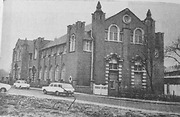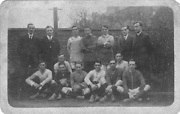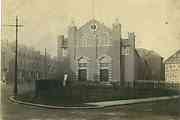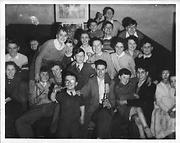 Hartlepool Sports & Leisure
Hartlepool Sports & Leisure
- Cinemas, Theatres & Dance Halls
- Musicians & Bands
- At the Seaside
- Parks & Gardens
- Caravans & Camping
- Sport
 Hartlepool Transport
Hartlepool Transport
- Airfields & Aircraft
- Railways
- Buses & Commercial Vehicles
- Cars & Motorbikes
- The Ferry
- Horse drawn vehicles
 A Potted History Of Hartlepool
A Potted History Of Hartlepool
- Unidentified images
- Sources of information
- Archaeology & Ancient History
- Local Government
- Printed Notices & Papers
- Aerial Photographs
- Events, Visitors & VIPs
 Hartlepool Trade & Industry
Hartlepool Trade & Industry
- Trade Fairs
- Local businesses
- Iron & Steel
- Shops & Shopping
- Fishing industry
- Farming & Rural Landscape
- Pubs, Clubs & Hotels
 Hartlepool Health & Education
Hartlepool Health & Education
- Schools & Colleges
- Hospitals & Workhouses
- Public Health & Utilities
- Ambulance Service
- Police Services
- Fire Services
 Hartlepool People
Hartlepool People
 Hartlepool Places
Hartlepool Places
 Hartlepool at War
Hartlepool at War
 Hartlepool Ships & Shipping
Hartlepool Ships & Shipping

Westbourne Methodist Church
Details about Westbourne Methodist Church
The first building on the present site was the 'Tin Chapel' built in 1885. The current building was dedicated in 1906, although around 2000 the church part was demolished and services are now held in part of the large church hall area adjacent to it.
Location
Related items :
 Early Wartime Memories by David Willis
Early Wartime Memories by David Willis
David Willis no longer lives in the town but has kindly sent in his reminiscences of a Wartime childhood in Hartlepool.
In the late 1930s I remember the visit of the 'chocolate train', which was parked up in a dead end platform at the east end of West Hartlepool Station. The whole train was decked out in colours which from memory resembled the Cadbury colours. I made several visits as samples of various chocolates were on display and were given away to hungry kids like me. I wonder if anyone else remembers the 'chocolate train', which left many very sad small people as it finally pulled out of the station.
The other major event was the spectacular burning down of Dyke House Farm and its surrounding buildings, which I think must have been organised by the Fire Brigade, as I distinctly remember Firemen silhouetted against the flames as the fire took hold. There was also an accompanying firework display. It seemed to me that most of the town must be in attendance as we looked on from Wharton Terrace. This was prior to the house-building on the site and also that of Dyke House School, which never got beyond the foundation stage before the onset of the War, but provided a magnificent playground for children.
With regard to St Oswald Street itself, it had its own garrison of troops, stationed in a building at the Raby Road end of the street. The building was Waugh's Bakery and the soldiers were from a Scottish regiment resplendent in their kilts. Each evening a lone piper would march up and down the street. The soldiers used a large sliding door in Wharton Terrace backlane to access the building and a well-known tramp could often be seen near this door looking for scraps of food. One day the soldiers put him in a barrel of water and scrubbed him clean. Waugh's also had a cake and bread shop immediately opposite the bakery. In addition there was a further shop at the other end of the street, known as McGhees general store.
Prewar the United Bus Company had a garage on Raby Road immediately opposite St Oswald's Street which was taken over as a Fire Station for the duration, housing several large engines.
In the early years of the War, Brougham School was taken over by the army. Many of the pupils spent the next 3 or 4 years getting a part-time education in houses. For example, a group of pupils from the St Oswald Street/Chester Road area met for about three half-days a week in my parent's house (12 St Oswald's Street), next door at number 10, or at a house at the Raby Road end of Chester Road.
When Dyke House opened we resumed full time education there and I can remember growing vegetables in the quadrangles in the 'Dig for Victory' campaign. I was there for 1 or 2 years and my teacher was Miss Salt. I took the 11 plus at Dyke House before moving on to West Hartlepool Grammar School in September 1945.
Just postwar I joined the youth club run by Westbourne Church between Stranton and the Burn Valley. We had a very successful football team, playing as far afield as Darlington and Sunderland. We were known as the Guild of Youth, a future well known team member being Brian London who fought Mohammed Ali for the World Heavyweight title. I was at the Grammar School at the time, a bastion of rugby, where the Headmaster insisted on boys playing rugby in winter if they wished to play cricket in summer, which I loved. This led to all sorts of rushing journeys between morning rugby matches and afternoon soccer games, especially if these were 20 miles apart.
More detail » Westbourne Church 1960s
Westbourne Church 1960s
 Created by NDM
Donated by Hartlepool Museum Service
Created by NDM
Donated by Hartlepool Museum ServiceThis view shows the church and church hall in the late 1960s. Around 2000, the church itself was demolished leaving the still quite extensive church hall premises (the building on the far left) as Westbourne Church and hall. Presumably it cost a considerable amount in upkeep for such large buildings. The land where the church had been is still wasteland.
More detail » Westbourne FC
Westbourne FC
 Donated by Alys Delafield
Donated by Alys DelafieldDated 1918
Dated 1918, this is Westbourne Methodist Church football team probably according to the reverse at Easington Colliery. The minister appears to be on the right.
More detail » Westbourne Methodist Church
Westbourne Methodist Church
 Donated by Douglas Ferriday
Donated by Douglas FerridayPart of the Hartlepool Library Service collection
Dated 1964
A view of the exterior of the church on Stockton Road. Premises now demolished
More detail » Westbourne Methodist Church
Westbourne Methodist Church
 Created by Unknown
Donated by Westbourne Methodist Church
Created by Unknown
Donated by Westbourne Methodist ChurchPart of the Vestry Records collection
Dated 2018
A rare picture of Westbourne Methodist Church showing the front of the original building without the current group of mature Trees.
The picture is undated but prominent are the trolley bus posts and the houses at the bottom of Westmoreland Street are private homes and not shops as they were later to become. The prominent poster at the Church entrance cannot be read.
The buildings of the building business on the extreme right are now used by a garage business.
More detail »
 Westbourne Methodist Church Youth Group 1957
Westbourne Methodist Church Youth Group 1957
 Donated by Jacky Armstrong
Donated by Jacky ArmstrongDated 1957
Junior Church Youth group around 1957.
More detail » Westmoreland St and Westbourne Church
Westmoreland St and Westbourne Church
 Part of the Library collection collection
Part of the Library collection collectionThe image is taken from Westmoreland Street looking across to the now demolished Westbourne Methodist Church. To the left of the large church is the church hall which was built alongside and is now used as both Westbourne Church and hall.
HHT&N 235
More detail »



